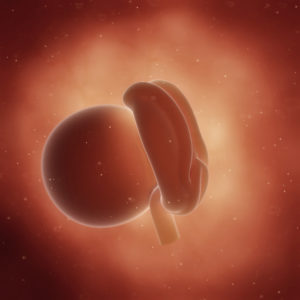My First Trimester
Week 5
Estimated Reading Time: 8 minutes The embryonic period begins the fifth week of pregnancy, or just the third week after conception. At this time, the embryo is developing rapidly; the baby’s brain, spinal cord, heart and other organs begin to form. The embryo is now very vulnerable to harm from substances delivered from the mother such as cigarette smoke, medications, illegal drugs or alcohol.
The embryonic period begins the fifth week of pregnancy, or just the third week after conception. At this time, the embryo is developing rapidly; the baby’s brain, spinal cord, heart and other organs begin to form. The embryo is now very vulnerable to harm from substances delivered from the mother such as cigarette smoke, medications, illegal drugs or alcohol.
The embryo commences a vital month of growth now. The miracle of every cell doing its job in exactly the right location begins, each with its own essential and separate role. Not even the latest research or most learned researcher can explain this completely.
Three layers now create the embryo. The outer layer of cells, the ectoderm, defines both complex and simple beginnings for your baby. This outermost layer of skin along with the central and peripheral nervous systems, portions of the lungs, eyes, inner ear, tooth enamel and many connective tissues now spring into action. The middle layer of cells, the mesoderm, will form your baby’s heart and blood; a primitive circulatory system will take shape. Now, the basis for your baby’s bones, muscles, kidneys and much of the reproductive system is realized. Your baby’s heartbeat is now possibly noticeable on an ultrasound. The inner layer of cells, the endoderm, develops into an uncomplicated tube entwined with mucous membranes. The baby’s bladder, liver, intestines and lungs develop here.
By the conclusion of this week, your baby is as tiny as the point of a lead pencil. What a busy and brilliant week it has been!
Scheduling Your First Visit With Your Health Care Team
 This is a perfect time to contact your health care team to schedule your first appointment. It’s unusual to have your first prenatal appointment prior to 8 weeks, but it can’t hurt to see your health care team, do some blood tests, and make sure the pregnancy hormone values are acceptable (hCG and progesterone).
This is a perfect time to contact your health care team to schedule your first appointment. It’s unusual to have your first prenatal appointment prior to 8 weeks, but it can’t hurt to see your health care team, do some blood tests, and make sure the pregnancy hormone values are acceptable (hCG and progesterone).
Chiropractic Care Co-managing Your Pregnancy
Incorporating Chiropractic Care in a woman’s forty-week gestational journey may be very beneficial. A woman’s body begins to undergo many changes during pregnancy. Pelvic transformations, the quickly increasing size of the abdomen, which causes increased back curvature, and the beginning of postural differences, begin manifesting. Chiropractors can help by correctly aligning the spinal cord, which can help the body function at its best during this time.
Most chiropractors can assist in the co-management of your pregnancy. According to Dr. Robin June, B.S., D.C., of The Corporate Chiropractor Center for Health and Human Performance in Atlanta, Georgia, back pain is experienced by fifty percent of women during their pregnancy and fifty to seven-five percent of pregnant women during labor. Dr. June tells us that one cross-sectional survey in the Journal of Alternative and Complementary Medicine reported that thirty-one percent of its respondents used alternative therapies during pregnancy and that chiropractic care was the third most common form of treatment sought behind massage and yoga.
Relief From Back Pain During Pregnancy
So why is there back pain in pregnancy? The female sacrum, the major triangular bone in your pelvis, has enough depth to carry the displaced weight gain of 25-35 pounds. However this will greatly increase the stress to a pregnant woman’s sacroiliac joints, which are the thin joints at the junction of your spine and pelvis. As the pregnancy progresses, this new weight of the baby is projected forward and the lumbar lordosis (the curve at the base of your spine) increases. Two things will then begin to happen. First, this increased weight places extra stress on the vertebrae discs that act as shock absorbers between each of the vertebrae in your spinal column. Second, the facet joints pivot and slide against one another. These joints work in tandem giving the neck and back its range of motion and help to support body weight and limit movements that would harm the delicate nerve structure in the spine. The increasing weight of your baby on the intervertebral discs and the facet joints can cause back pain and sciatica.
The elevated pregnancy levels of progesterone, estrogen, and relaxin, a hormone that helps a woman’s body physically become a bit looser throughout pregnancy, especially during the third trimester, create pelvic hypermobility that causes the joints to stretch much further than normal. This in turn results in a decrease in spinal stabilization. The direct pressure from the developing baby rests on the pregnant mom’s lumbosacral nerve roots. These nerve roots are the first segments of a nerve as it leaves the central nervous system providing sensation and motor control to the back, buttocks, legs and feet. Compression of these nerves may result in pain.
The Journal of Midwifery Women’s Health reports the average number of chiropractic treatments when substantial relief was achieved was 1.8 treatments. No adverse effects of the treatment were reported. Studies have also shown that seventy percent of pregnant patients who received chiropractic care during their pregnancies stated that they found relief from pain. The authors of these studies have also noted that chiropractic manipulation may significantly decrease the incidence of “back labor.”
Shorter Duration of Labor and Delivery
The Textbook On Chiropractic And Pregnancy states that there may be a relationship between back pain throughout pregnancy and a longer labor and delivery. In reviewing previous statistics, first time pregnant women who seek chiropractic care throughout their pregnancies have, on average, a twenty-five percent shorter labor time, whereas women who are on their second or third pregnancies who seek chiropractic care on average have a thirty-one percent shorter labor time.
Resolution of Breech Position
In addition, a specific chiropractic adjustment called the Webster Technique may be helpful for women in their eighth month of pregnancy whose baby is breech. In fact, ninety-two percent of cases that used this chiropractic technique resulted in the resolution of a breech position. Many of these presentations would have otherwise required cesarean deliveries. Although some babies in the breech position will convert to a head-down (vertex) position before 34 weeks of gestation, research indicates that only about nine percent will do so spontaneously.
The chiropractor’s role when presented with a breech position is to balance the pelvis and corresponding muscles and ligaments to remove any constraint to the patient’s uterus to allow the baby to assume the correct position. At no time does the chiropractor attempt to change the position of the baby; the chiropractor only attempts to correct a potential cause of intrauterine constraint.
 In contrast to the Webster Technique, obstetricians may attempt to correct a breech presentation by using the External Cephalic Version (ECV). In performing this version, the doctor places both hands on the top of the pregnant abdomen — one by the baby’s head and the other by the baby’s buttocks — pushing and rolling the fetus into a vertex position.
In contrast to the Webster Technique, obstetricians may attempt to correct a breech presentation by using the External Cephalic Version (ECV). In performing this version, the doctor places both hands on the top of the pregnant abdomen — one by the baby’s head and the other by the baby’s buttocks — pushing and rolling the fetus into a vertex position.
An increasing number of practitioners and obstetricians are realizing the benefits of chiropractic manual therapy for their pregnant patients. The inclusion of chiropractic care during pregnancy and labor is becoming more widely accepted.
Speak with your health care team if you would like to find a chiropractor in your area and please visit Brimhall Wellness.
hCG And Progesterone Levels During Pregnancy
According to the American Pregnancy Association, Promoting Pregnancy Wellness:
Your hCG level should rise and double every 48 -72 hours. Progesterone is the hormone that helps maintain pregnancy until birth. If progesterone supplements are needed, now is a better time to know. Basically, your body (or the corpus luteum) should create enough progesterone until week 12 or so when the placenta takes over that role. However, sometimes a woman can have difficulties in this area and can experience an early loss of her baby (miscarriage). It’s always better to know now than to find out later.
Guideline to hCG levels during pregnancy (singleton pregnancy):
hCG levels in weeks from LMP (gestational age)* :
- 3 weeks LMP: 5 – 50 mIU/ml
- 4 weeks LMP: 5 – 426 mIU/ml
- 5 weeks LMP: 18 – 7,340 mIU/ml
- 6 weeks LMP: 1,080 – 56,500 mIU/ml
- 7 – 8 weeks LMP: 7,650 – 229,000 mIU/ml
- 9 – 12 weeks LMP: 25,700 – 288,000 mIU/ml
- 13 – 16 weeks LMP: 13,300 – 254,000 mIU/ml
- 25 – 40 weeks LMP: 3,640 – 117,000 mIU/ml
- Non-pregnant females: <5.0 mIU/ml
- Postmenopausal: <9.5 mIU/ml
Guideline to Progesterone levels during pregnancy (singleton pregnancy):
- 1-28 ng/ml Mid Luteal Phase (Average is over 10 for un-medicated cycles and over 15 with medication use)
- 9-47 ng/ml First trimester
- 17-146 ng/ml Second Trimester
- 49-300 ng/ml Third Trimester
*There are many averages for progesterone levels. These charts are a very broad guideline—speak with your health care professional for more specific guidelines for you.
**Remember-These numbers are just a GUIDELINE– every woman’s hormone level can rise differently. It is not necessarily the level that matters but rather the change in the level.
If you encounter any of the following physical symptoms, call and ask your health care team for solutions or support: tender and sore breasts, short or long or even constant periods of nausea, frequent urination, fatigue, food likes and dislikes, light headedness or dizziness, heartburn or constipation. These may be normal or not so normal symptoms. Your health care team is there to educate and inform you, don’t hesitate to seek medical advice!